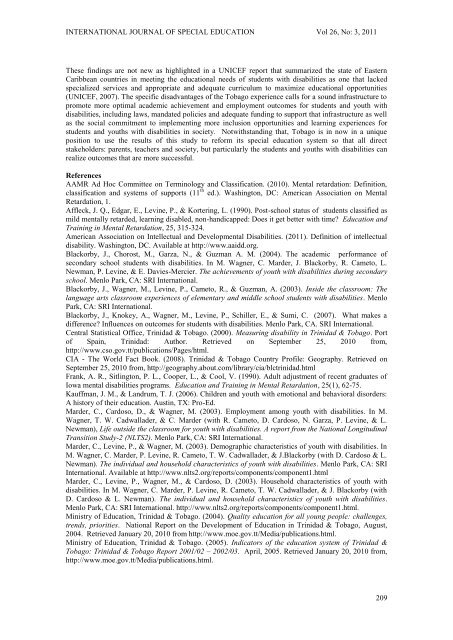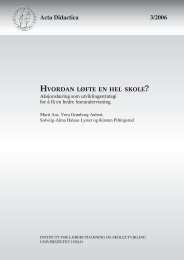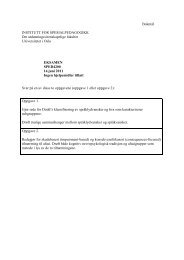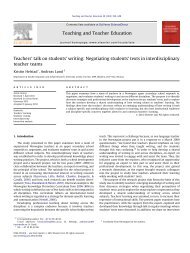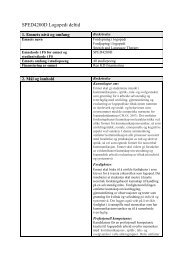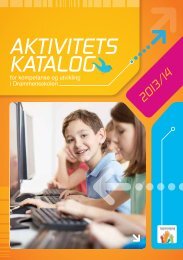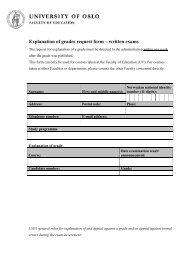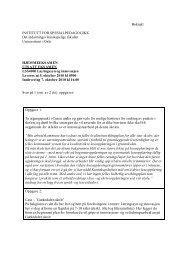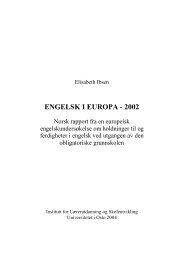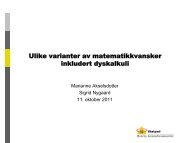International Journal Special Education
International Journal Special Education
International Journal Special Education
You also want an ePaper? Increase the reach of your titles
YUMPU automatically turns print PDFs into web optimized ePapers that Google loves.
INTERNATIONAL JOURNAL OF SPECIAL EDUCATION Vol 26, No: 3, 2011These findings are not new as highlighted in a UNICEF report that summarized the state of EasternCaribbean countries in meeting the educational needs of students with disabilities as one that lackedspecialized services and appropriate and adequate curriculum to maximize educational opportunities(UNICEF, 2007). The specific disadvantages of the Tobago experience calls for a sound infrastructure topromote more optimal academic achievement and employment outcomes for students and youth withdisabilities, including laws, mandated policies and adequate funding to support that infrastructure as wellas the social commitment to implementing more inclusion opportunities and learning experiences forstudents and youths with disabilities in society. Notwithstanding that, Tobago is in now in a uniqueposition to use the results of this study to reform its special education system so that all directstakeholders: parents, teachers and society, but particularly the students and youths with disabilities canrealize outcomes that are more successful.ReferencesAAMR Ad Hoc Committee on Terminology and Classification. (2010). Mental retardation: Definition,classification and systems of supports (11 th ed.). Washington, DC: American Association on MentalRetardation, 1.Affleck, J. Q., Edgar, E., Levine, P., & Kortering, L. (1990). Post-school status of students classified asmild mentally retarded, learning disabled, non-handicapped: Does it get better with time? <strong>Education</strong> andTraining in Mental Retardation, 25, 315-324.American Association on Intellectual and Developmental Disabilities. (2011). Definition of intellectualdisability. Washington, DC. Available at http://www.aaidd.org.Blackorby, J., Chorost, M., Garza, N., & Guzman A. M. (2004). The academic performance ofsecondary school students with disabilities. In M. Wagner, C. Marder, J. Blackorby, R. Cameto, L.Newman, P. Levine, & E. Davies-Mercier. The achievements of youth with disabilities during secondaryschool. Menlo Park, CA: SRI <strong>International</strong>.Blackorby, J., Wagner, M., Levine, P., Cameto, R., & Guzman, A. (2003). Inside the classroom: Thelanguage arts classroom experiences of elementary and middle school students with disabilities. MenloPark, CA: SRI <strong>International</strong>.Blackorby, J., Knokey, A., Wagner, M., Levine, P., Schiller, E., & Sumi, C. (2007). What makes adifference? Influences on outcomes for students with disabilities. Menlo Park, CA. SRI <strong>International</strong>.Central Statistical Office, Trinidad & Tobago. (2000). Measuring disability in Trinidad & Tobago. Portof Spain, Trinidad: Author. Retrieved on September 25, 2010 from,http://www.cso.gov.tt/publications/Pages/html.CIA - The World Fact Book. (2008). Trinidad & Tobago Country Profile: Geography. Retrieved onSeptember 25, 2010 from, http://geography.about.com/library/cia/blctrinidad.htmlFrank, A. R., Sitlington, P. L., Cooper, L., & Cool, V. (1990). Adult adjustment of recent graduates ofIowa mental disabilities programs. <strong>Education</strong> and Training in Mental Retardation, 25(1), 62-75.Kauffman, J. M., & Landrum, T. J. (2006). Children and youth with emotional and behavioral disorders:A history of their education. Austin, TX: Pro-Ed.Marder, C., Cardoso, D., & Wagner, M. (2003). Employment among youth with disabilities. In M.Wagner, T. W. Cadwallader, & C. Marder (with R. Cameto, D. Cardoso, N. Garza, P. Levine, & L.Newman), Life outside the classroom for youth with disabilities. A report from the National LongitudinalTransition Study-2 (NLTS2). Menlo Park, CA: SRI <strong>International</strong>.Marder, C., Levine, P., & Wagner, M. (2003). Demographic characteristics of youth with disabilities. InM. Wagner, C. Marder, P. Levine, R. Cameto, T. W. Cadwallader, & J.Blackorby (with D. Cardoso & L.Newman). The individual and household characteristics of youth with disabilities. Menlo Park, CA: SRI<strong>International</strong>. Available at http://www.nlts2.org/reports/components/component1.htmlMarder, C., Levine, P., Wagner, M., & Cardoso, D. (2003). Household characteristics of youth withdisabilities. In M. Wagner, C. Marder, P. Levine, R. Cameto, T. W. Cadwallader, & J. Blackorby (withD. Cardoso & L. Newman). The individual and household characteristics of youth with disabilities.Menlo Park, CA: SRI <strong>International</strong>. http://www.nlts2.org/reports/components/component1.html.Ministry of <strong>Education</strong>, Trinidad & Tobago. (2004). Quality education for all young people: challenges,trends, priorities. National Report on the Development of <strong>Education</strong> in Trinidad & Tobago, August,2004. Retrieved January 20, 2010 from http://www.moe.gov.tt/Media/publications.html.Ministry of <strong>Education</strong>, Trinidad & Tobago. (2005). Indicators of the education system of Trinidad &Tobago: Trinidad & Tobago Report 2001/02 – 2002/03. April, 2005. Retrieved January 20, 2010 from,http://www.moe.gov.tt/Media/publications.html.209


